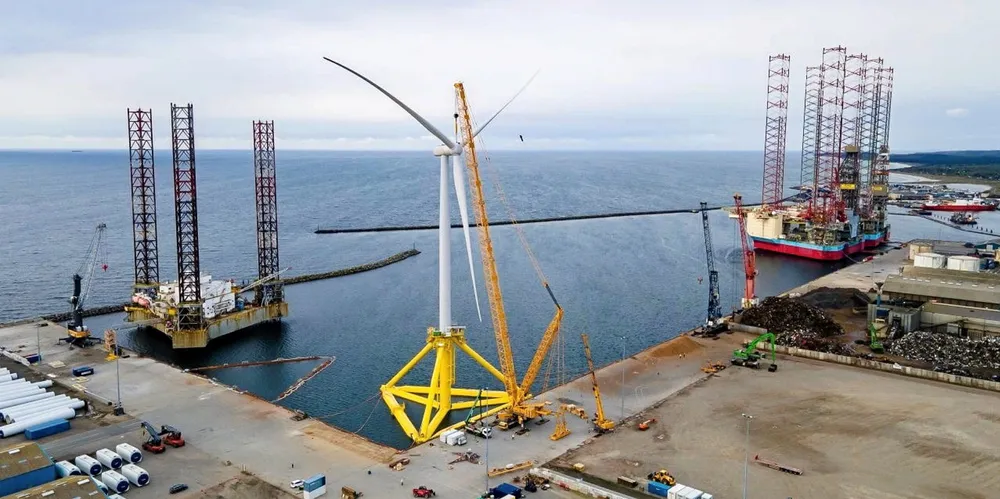UK channels $80m to floating wind technologies 'key to unlocking' British sea-power
UK's deep-water wind potential in the cross-hairs as public-private demonstrator funding goes to eleven consortia, featuring key players including Stiesdal Offshore Technologies, Aker Solutions and JDR Cables

Development of the UK’s deep-water wind power resource has been given a major fillip with over £60m ($81m) awarded to a range of technologies under a key government-industry funding programme, including several projects advancing next-generation platform designs.
<b>Focus your mind: get the insight you need with the Recharge Agenda</b>
The global energy transition is gathering momentum – and the accompanying news-stream becoming an information deluge. Separate the green giants from the greenwash and the hard facts from the click-bait headlines with Recharge Agenda, our curation of the market-making events of the week, distilled down into one quick-read newsletter. Sign up here for free
Consortia headed by Copenhagen Offshore Partners, SenseWind and Trivane, which are leading developments that are looking to test innovative semisubmersible, tension leg platform (TLP) and trimaran concepts, respectively, took the lion’s share of the Floating Offshore Wind Demonstration Programme (FOWDP), part of the British government’s £1bn so-called Net Zero Innovation Portfolio set up to accelerate commercialisation of low-carbon technologies in industrial sectors.
“[The UK is] already a world leader in offshore wind and floating technology is key to unlocking the full potential of the seas around Britain,” said energy minister Greg Hands. “These innovative projects will help us expand renewable energy further and faster across the UK and help to reduce our exposure volatile global gas prices.
“By stimulating development now through the FOWDP, the costs of building and locating floating turbines in deep-water areas will come down faster, growing the UK supply chain and supporting the target in the [government’s] Ten Point Plan of delivering 1GW of energy through floating wind by 2030.”
The SenseWind-led group, which includes Geodis FF, Xodus and the Offshore Renewable Energy Catapult also pocketed £10m for a project marrying a compact TLP floating foundation with a novel anchoring system that allows for cost-saving maintenance to be performed at sea.
“The Achilles heel of floating wind is the ‘tow back to shore’ challenge for turbine maintenance and major component swap out. The Sense concept directly addresses this problem, removing the need to move the floating foundation off station,” said Julian Brown, a non-executive director of SenseWind. “The lifetime cost reduction in the floating sector will be enormous.”
Trivane and partners London Marine Consultants, Keynvormorlift and Ledwood, won in excess of £3m to progress a trimaran floating wind power platform consisting of three barge-like structures that together ‘weathervane’ around a turret mooring system.
The matched-cash boost will also help a number of research and development projects for technologies including cabling and anchoring systems and innovative floating substation design.
British industry advocacy body RenewableUK’s CEO, Dan McGrail, said: “Today’s announcement will help the UK to develop floating wind technology faster and bring down costs for consumers. The UK is currently the biggest market in the world for this cutting-edge technology and other countries are following our lead.
“Investing in innovation is vital to build up a UK supply chain that can meet the needs of our domestic market and seize the global opportunities that floating wind offers”.
<b>UK Floating Offshore Wind Demonstration Programme winners</b>
JDR Cables and the Offshore Renewable Energy (ORE) Catapult: £1.6m for developing and testing electric cabling systems;
Buoyant Production Technologies and the University of Southampton: £239,000 to demonstrate that a patented design can be used for supporting substation;
AWC Technology: £761,000 for development of a cost-cutting articulated wind turbine column
Reflex Marine, the University of Exeter, Bridon Bekaert Ropes and Wood Thilsted: £882,000 for development of a novel low-cost anchoring system
London Marine Consultants and the University of Plymouth: £265,000 for a 'simplifying' mooring system
Copenhagen Offshore Partners, SSE Renewables, Maersk Supply Service Subsea and Bridon Bekaert Ropes: £9.7m to demonstrate new mooring system technologies, cable protection, floating turbine base design and an advanced digital monitoring system
Marine Power Systems: £3.5 to develop a compact floating foundation with integrated wave energy generator
Cerulean Winds: £826,000 for an integrated floating wind power system for deployment at an offshore oil & gas facility in the UK North Sea
SenseWind, Geodis FF, Xodus, and ORE Catapult: £10m for a project combining a compact floating foundation with a novel anchoring system
Aker Solutions: £691,000 for developing a subsea substation design connecting floating wind farms to the energy grid
Trivane, London Marine Consultants, Keynvormorlift and Ledwood: £3.3m for developing a trimaran mounting system for wind turbines